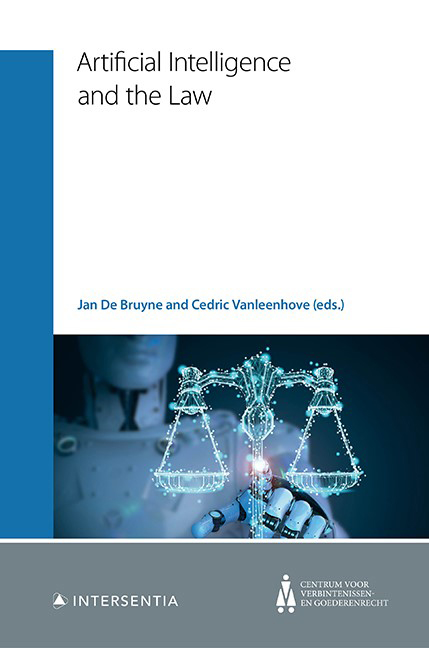Book contents
- Frontmatter
- Contents
- Foreword
- Contributing Authors
- Chapter 1 Basic Concepts of AI for Legal Scholars
- Chapter 2 Different Models of Innovation and Their Relation to Law
- Chapter 3 Setting the Scene: On AI Ethics and Regulation
- Chapter 4 Quantitative Legal Prediction: the Future of Dispute Resolution?
- Chapter 5 AI Arbitrators … ‘Does Not Compute’
- Chapter 6 AI through a Human Rights Lens. The Role of Human Rights in Fulfilling AI’s Potential
- Chapter 7 Killer Robots: Lethal Autonomous Weapons and International Law
- Chapter 8 AI and Data Protection: the Case of Smart Home Assistants
- Chapter 9 AI and IP: a Tale of Two Acronyms
- Chapter 10 Tax and Robots
- Chapter 11 Robotisation and Labour Law. The Dark Factory: the Dark Side of Work?
- Chapter 12 The Hypothesis of Technological Unemployment Caused by AI-Driven Automation and its Impact on Social Security Law
- Chapter 13 AI in Belgian Contract Law: Disruptive Challenge or Business as Usual?
- Chapter 14 Tort Law and Damage Caused by AI Systems
- Chapter 15 Insurance Underwriting on the Basis of Telematics: Segmentation and Profiling
- Chapter 16 AI and Creditworthiness Assessments: the Tale of Credit Scoring and Consumer Protection. A Story with a Happy Ending?
- Chapter 17 AI and the Consumer
- Chapter 18 Robots and AI in the Healthcare Sector: Potential Existing Legal Safeguards Against a(n) (Un)justified Fear for ‘Dehumanisation’ of the Physician-Patient Relationship
Chapter 11 - Robotisation and Labour Law. The Dark Factory: the Dark Side of Work?
Published online by Cambridge University Press: 26 May 2021
- Frontmatter
- Contents
- Foreword
- Contributing Authors
- Chapter 1 Basic Concepts of AI for Legal Scholars
- Chapter 2 Different Models of Innovation and Their Relation to Law
- Chapter 3 Setting the Scene: On AI Ethics and Regulation
- Chapter 4 Quantitative Legal Prediction: the Future of Dispute Resolution?
- Chapter 5 AI Arbitrators … ‘Does Not Compute’
- Chapter 6 AI through a Human Rights Lens. The Role of Human Rights in Fulfilling AI’s Potential
- Chapter 7 Killer Robots: Lethal Autonomous Weapons and International Law
- Chapter 8 AI and Data Protection: the Case of Smart Home Assistants
- Chapter 9 AI and IP: a Tale of Two Acronyms
- Chapter 10 Tax and Robots
- Chapter 11 Robotisation and Labour Law. The Dark Factory: the Dark Side of Work?
- Chapter 12 The Hypothesis of Technological Unemployment Caused by AI-Driven Automation and its Impact on Social Security Law
- Chapter 13 AI in Belgian Contract Law: Disruptive Challenge or Business as Usual?
- Chapter 14 Tort Law and Damage Caused by AI Systems
- Chapter 15 Insurance Underwriting on the Basis of Telematics: Segmentation and Profiling
- Chapter 16 AI and Creditworthiness Assessments: the Tale of Credit Scoring and Consumer Protection. A Story with a Happy Ending?
- Chapter 17 AI and the Consumer
- Chapter 18 Robots and AI in the Healthcare Sector: Potential Existing Legal Safeguards Against a(n) (Un)justified Fear for ‘Dehumanisation’ of the Physician-Patient Relationship
Summary
INTRODUCTION
1. At the shareholders meeting in 2016, Elon Musk presented the Tesla factory as ‘the machine that makes the machine’. He referred to this machine-making machine in the context of Tesla's manufacturing plant that would not need much human involvement. The goal was to produce cars by using smart robots and with as few employees as possible in the assembly line. However, the production of these cars incurred serious delays. In 2018, Elon Musk had to admit that he had relied too much on the capabilities of robots and that ‘humans are underrated’. Another example of underestimating human input in robotised work environments is the robotic production of Adidas shoes. The company had to shut down these factories after two years because the robots could not meet the requirements of the flexible production rate. It was more difficult to retrain than to rely on human workers instead.
2. These examples express the idea of the so-called ‘Dark Factory’, which refers to manufacturing plants using intelligent machines and systems that require hardly any involvement of human operators. This would lead to a factory that can operate in the dark without any lights. However, the examples mentioned above show that human workers are still needed in these robotised work environments. This is taken as guiding principle throughout this entire chapter. When it comes to robots that replace human workers, this chapter argues that fully automated working environments cannot be created with the current technological capabilities of robots. On the contrary, robots will perform only a part of the tasks of human workers. Therefore, human workers and robots will have to work more closely together. This will have an impact on the relationship between them. As will be discussed below, this evolving humanrobot relationship will change the working conditions for workers and will affect the employment relationship.
3. This chapter does not disregard the fact that robots have been part of manufacturing plants for several decades. Nevertheless, it will be argued that the view of the robot in the workplace as a huge robot arm in the assembly line will soon become outdated or might already be outdated.
- Type
- Chapter
- Information
- Artificial Intelligence and the Law , pp. 285 - 316Publisher: IntersentiaPrint publication year: 2021
- 1
- Cited by



